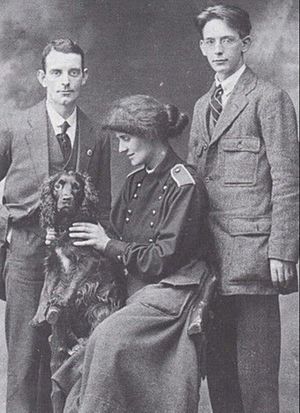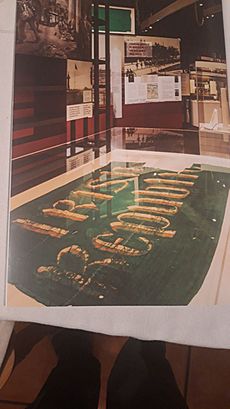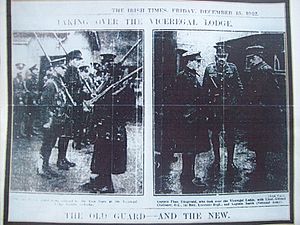Theobald Wolfe Tone FitzGerald facts for kids
Quick facts for kids
Theobald Wolfe Tone FitzGerald
|
|
|---|---|
|
Tiobóid Mac Gearailt
|
|

Countess Markievicz, her dog 'Poppett', Theobald Wolfe Tone FitzGerald (right) and Thomas McDonald (left), members of Na Fianna Éireann, photographed at Waterford in 1917
|
|
| Personal details | |
| Born |
Theobald Wolfe Tone FitzGerald
14 June 1898 Dublin City, Ireland |
| Died | 27 March 1962 (aged 63) Dublin, Ireland |
| Political party | Fine Gael Sinn Féin |
| Spouse | Áine Malone |
| Awards | 1916 Medal, 1919-1921 Service Medal (Black and Tan Medal) |
| Military service | |
| Allegiance | |
| Branch/service | Irish Republican Army Irish Free State |
| Years of service | 1913-1924 |
| Rank | Captain Commandant (Major) |
| Unit | General Head Quarters |
| Commands | Commandant Óglaigh na hÉireann/National Forces service number SDR921 |
| Battles/wars | Easter Rising Irish War of Independence Irish Civil War |
Theobald Wolfe Tone FitzGerald (born June 14, 1898 – died March 27, 1962) was an Irish army officer and artist. He is famous for painting the "Irish Republic" flag. This flag flew over the General Post Office during the Easter Rising in 1916.
The British Army kept the flag as a prize. It was returned to Ireland in 1966 during special celebrations. Theobald was also related to important figures. His brother-in-law, Lieutenant Michael Malone, died in the 1916 Rising. He was also related to Seán Mac Mahon, a former army chief, and the politician Dan Breen.
Contents
Joining Na Fianna Éireann
Theobald FitzGerald was part of a group called "The Row Boys." This group included famous people like Patrick Pearse and Willie Pearse. His future brothers-in-law, Michael Malone and General Seán Mac Mahon, were also in this group. They all went to St. Andrew's Christian Brothers School in Dublin.
In 1909, while still a student, Theobald helped start Fianna Éireann. He and his brothers joined at the very first meeting. This happened when Countess Markievicz visited his classroom.
What was Na Fianna?
Na Fianna, often called the Fianna, was an Irish youth group. It was founded in 1909 by Bulmer Hobson and Constance Markievicz. Its goal was to promote Irish nationalism among young people.
Members of the Fianna helped create the Irish Volunteers. This was an armed group of Irish nationalists. Fianna members also joined a secret society called the Irish Republican Brotherhood (IRB).
Fianna's Role in History
The Fianna played a part in important events. They helped with the Howth gun-running in 1914. This was when weapons were brought into Ireland. As members of the Volunteers, they also fought in the 1916 Easter Rising.
During the Irish War of Independence, they were very active. Later, in the Irish Civil War, they supported the side that opposed the peace treaty.
Theobald's Role in Fianna
After the Easter Rising, Theobald helped reorganize the Fianna. He was a Captain of Fianna Company No. 5 from 1916 to 1917. He later became a Commandant (a leader) of the 2nd Dublin Battalion.
He also worked at the Fianna's main headquarters. He helped with training and organizing members.
Leaving the Fianna
In December 1919, Theobald left his duties with the Fianna. He then joined the Engineers Battalion of the Dublin Brigade IRA. In 1920, he was arrested and held in several prisons. He was finally released in December 1921.
In 1922, he joined the National Army. He rose to the rank of Commandant before leaving the army in 1924.
The 1916 Easter Rising
Theobald FitzGerald was a member of Fianna Éireann. Through this group, he met Countess Constance Markievicz. Before the Easter Rising, he painted the words "Irish Republic" on a flag at her house in Rathmines.
This flag flew over the General Post Office during the fighting. The battle took place from April 24 to 29, 1916. The British Army took the flag as a prize. It was returned to Ireland during the 1966 celebrations.
Theobald and his four brothers, William, Thomas, Leo, and James, also fought in the Rising. They were in the area of Boland’s Mills and Boland’s Bakery. They fought under the command of Éamon de Valera. After the Rising ended, Theobald was held in Richmond Barracks until June 1916.
The War of Independence
Theobald FitzGerald served throughout the Irish War of Independence. He was part of B Company, 3rd Battalion Dublin Brigade. He held leadership roles in Fianna Éireann, including Officer Commanding Sluagh Sean Heuston. He also served with the Engineers Battalion and at General Headquarters.
Civil War and Arrest
During the Irish Civil War, he supported the Pro-Treaty side. He served as a Commandant in the National Forces. He was arrested and held from December 1920 to December 1921.
Before his arrest, he took part in several actions. These included operations at Kingsbridge Railway Station in Dublin. He also helped capture Royal Irish Constabulary cars from Archer's on Grand Canal Street, Dublin.
A Brother's Sacrifice
His brother, Leo, was killed during the Irish War of Independence. This happened on March 14, 1921, when Leo was 31 years old. Leo was part of an IRA unit guarding a meeting. The police raided the meeting, and Leo was killed in the gun battle that followed.
Joining the Free State Army
In early 1922, Theobald FitzGerald joined the new National Army. As a Captain, he took control of the Viceregal Lodge on December 15, 1922. Today, this building is known as Áras an Uachtaráin, the home of the President of Ireland. He took it over from Lieutenant Colonel Edward Challenor.
Theobald continued to serve as a staff officer. He left the Defence Forces in March 1924. He retired with the rank of Commandant.
Personal Life
Theobald FitzGerald married Áine (Annie) Malone. Áine was a member of Cumann na mBan, an Irish women's organization. She was also the sister of Michael Malone, who died during the 1916 Easter Rising.
Theobald and Áine had four children: Theobald, Nuala, Eithne, and Míċeál. His sister, Lucinda, married General Seán Mac Mahon, who was a Chief of General Staff. Áine's sister, Brigid, married Dan Breen. Dan Breen was a volunteer in the Irish Republican Army during the Irish War of Independence. He later became a Teachta Dála, which means a Member of Parliament, for the Fianna Fáil party.



